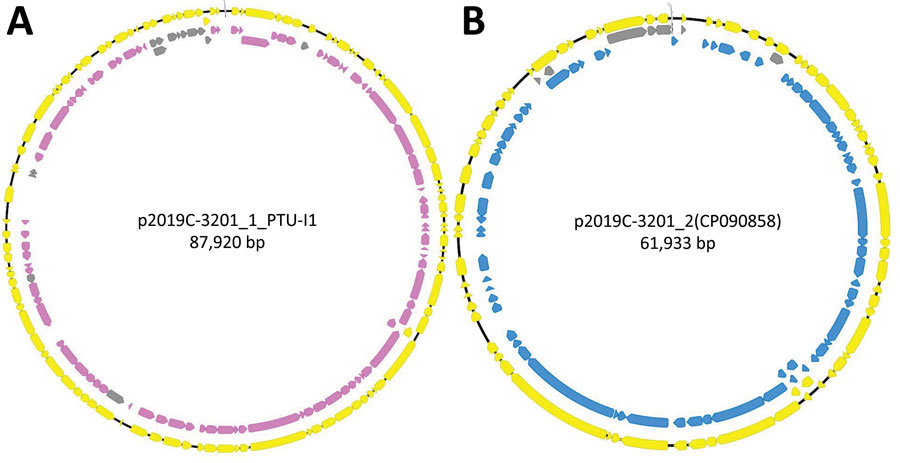Volume 29, Number 9—September 2023
Dispatch
Reoccurring Escherichia coli O157:H7 Strain Linked to Leafy Greens–Associated Outbreaks, 2016–2019
Figure 2

Figure 2. Annotated plasmids of reference genome 2019C-3201 of Escherichia coli O157:H7 containing clade-specific genomic features. A) p2019C-3201_1 annotated with prokka version 1.14.5 (yellow annotations) (11). Mapped list of Roary features (pan_genome_references.fa) onto plasmid (95% nucleotide identity; gray annotations) (14). Features highlighted had >90 sensitivity and >90 specificity to a subset of clade 1 isolates (pink annotations). The region with specific/sensitive features covers a large portion of the plasmid and predominately contains genes encoding hypothetical proteins with unknown functions and common plasmid-associated genes. Three features did not map in Geneious because they were either below 95% identity (2 features) or were identified as partial copy (1 feature). B) p2019C-3201_2 annotated with prokka v1.14.5 (yellow annotations). Mapped list of Roary features (pan_genome_references.fa) onto plasmid (100% nucleotide identity; gray annotations). Features highlighted had >90 sensitivity and >97 specificity (blue annotations) to a subset of clade 1 isolates. The region with specific/sensitive features covers a large portion of the plasmid and is associated with conjugation. Image was generated using Geneious version 2021.2 (https://www.geneious.com).
References
- Scallan E, Hoekstra RM, Angulo FJ, Tauxe RV, Widdowson MA, Roy SL, et al. Foodborne illness acquired in the United States—major pathogens. Emerg Infect Dis. 2011;17:7–15. DOIPubMedGoogle Scholar
- Bielaszewska M, Schmidt H, Liesegang A, Prager R, Rabsch W, Tschäpe H, et al. Cattle can be a reservoir of sorbitol-fermenting shiga toxin-producing Escherichia coli O157:H(-) strains and a source of human diseases. J Clin Microbiol. 2000;38:3470–3. DOIPubMedGoogle Scholar
- Heiman KE, Mody RK, Johnson SD, Griffin PM, Gould LH. Escherichia coli O157 Outbreaks in the United States, 2003-2012. Emerg Infect Dis. 2015;21:1293–301. DOIPubMedGoogle Scholar
- Marshall KE, Hexemer A, Seelman SL, Fatica MK, Blessington T, Hajmeer M, et al. Lessons learned from a decade of investigations of Shiga toxin–producing Escherichia coli outbreaks linked to leafy greens, United States and Canada. Emerg Infect Dis. 2020;26:2319–28. DOIPubMedGoogle Scholar
- Tolar B, Joseph LA, Schroeder MN, Stroika S, Ribot EM, Hise KB, et al. An overview of PulseNet USA databases. Foodborne Pathog Dis. 2019;16:457–62. DOIPubMedGoogle Scholar
- Lin Y, Yuan J, Kolmogorov M, Shen MW, Chaisson M, Pevzner PA. Assembly of long error-prone reads using de Bruijn graphs. Proc Natl Acad Sci U S A. 2016;113:E8396–405. DOIPubMedGoogle Scholar
- Redondo-Salvo S, Bartomeus-Peñalver R, Vielva L, Tagg KA, Webb HE, Fernández-López, et al. COPLA, a taxonomic classifier of plasmids. BMC Bioinfo. 2021;22:390. DOIGoogle Scholar
- Katz LS, Griswold T, Williams-Newkirk AJ, Wagner D, Petkau A, Sieffert C, et al. A comparative analysis of the Lyve-SET phylogenomics pipeline for genomic epidemiology of foodborne pathogens. Front Microbiol. 2017;8:375. DOIPubMedGoogle Scholar
- Bouckaert R, Vaughan TG, Barido-Sottani J, Duchêne S, Fourment M, Gavryushkina A, et al. BEAST 2.5: An advanced software platform for Bayesian evolutionary analysis. PLOS Comput Biol. 2019;15:
e1006650 . DOIPubMedGoogle Scholar - Seemann T. Prokka: rapid prokaryotic genome annotation. Bioinformatics. 2014;30:2068–9. DOIPubMedGoogle Scholar
- Cherry JL. Recent genetic changes affecting enterohemorrhagic Escherichia coli causing recurrent outbreaks. Microbiol Spectr. 2022;10:
e0050122 . DOIPubMedGoogle Scholar - Punshon T, Jackson BP, Meharg AA, Warczack T, Scheckel K, Guerinot ML. Understanding arsenic dynamics in agronomic systems to predict and prevent uptake by crop plants. Sci Total Environ. 2017;581-582:209–20. DOIPubMedGoogle Scholar
- Page AJ, Cummins CA, Hunt M, Wong VK, Reuter S, Holden MTG, et al. Roary: rapid large-scale prokaryote pan genome analysis. Bioinformatics. 2015;31:3691–3. DOIPubMedGoogle Scholar
- Brynildsrud O, Bohlin J, Scheffer L, Eldholm V. Rapid scoring of genes in microbial pan-genome-wide association studies with Scoary. Genome Biol. 2016;17:238. DOIPubMedGoogle Scholar
1These first authors contributed equally to this article.
2Current affiliation: Tulane National Primate Research Center, Covington, Louisiana, USA.